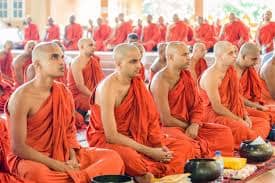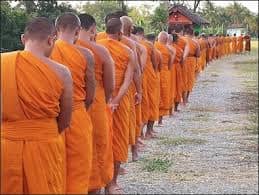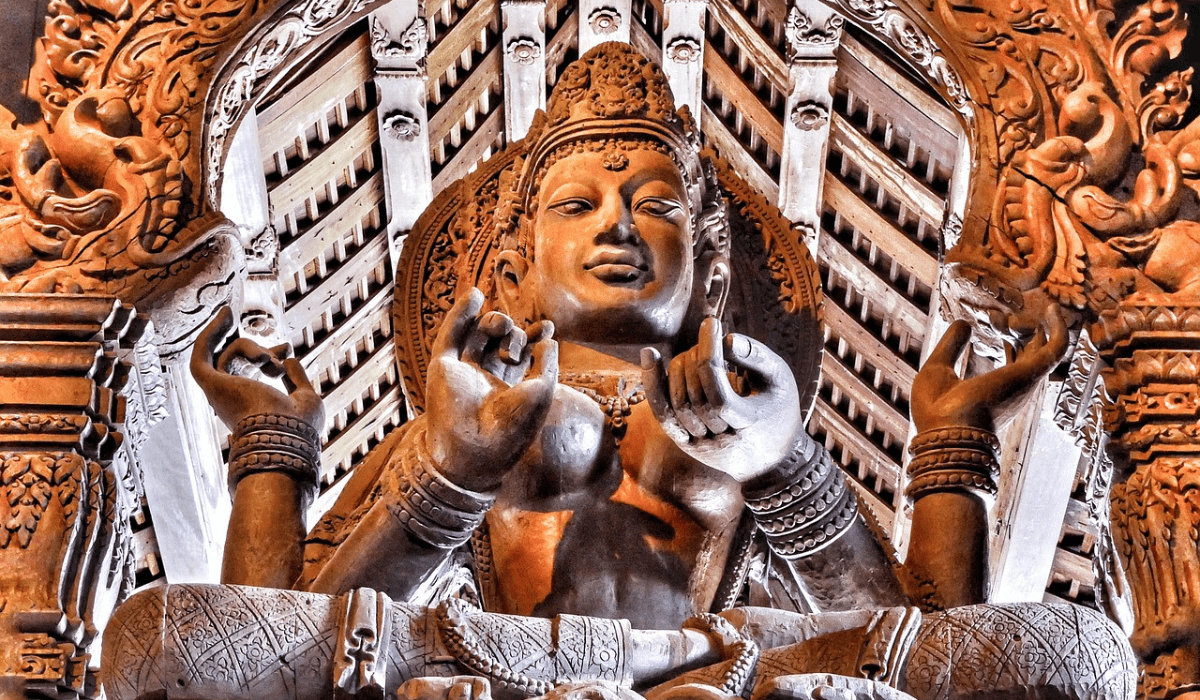Theravada Buddhism, often referred to as the “Teaching of the Elders,” is one of the oldest and most revered forms of Buddhism, deeply rooted in the traditions and teachings of Siddhartha Gautama, the Buddha. Predominantly practiced in Sri Lanka, Thailand, Myanmar, Laos, and Cambodia, Theravada Buddhism holds a unique place in the spiritual landscape of these countries, offering a rich tapestry of tradition, practice, and philosophy. This blog post aims to guide you through the essence of Theravada Buddhism, exploring its historical roots, core beliefs, rituals, and its relevance in modern society.
Table of Contents
I. Introduction to Theravada Buddhism
A. Historical Context
Origins in the Life of Siddhartha Gautama
Theravada Buddhism traces its origins to the life and teachings of Siddhartha Gautama, who attained enlightenment over 2,500 years ago in what is now modern-day India. His journey from prince to enlightened teacher laid the foundation for the spiritual path that millions follow today.
Development in the Indian Subcontinent
Following the Buddha’s death, his teachings, known as the Dharma, were preserved and transmitted orally by his disciples. Over time, these teachings were written down in the Pali Canon, forming the cornerstone of Theravada Buddhism. The tradition spread across the Indian subcontinent, eventually taking root in Sri Lanka and other parts of Southeast Asia.
Evolution Through the Ages and Geographic Spread
As Theravada Buddhism spread beyond India, it adapted to the cultural contexts of the regions it reached. In Sri Lanka, for instance, it became deeply intertwined with the island’s cultural identity, influencing everything from art to governance. Despite its regional variations, the core teachings of Theravada Buddhism have remained remarkably consistent, emphasizing the original teachings of the Buddha.





B. Core Beliefs and Principles
The Four Noble Truths
At the heart of Theravada Buddhism lie the Four Noble Truths, which encapsulate the Buddha’s insights into the nature of suffering and the path to its cessation:
- The Truth of Suffering (Dukkha): Life is permeated by suffering, impermanence, and dissatisfaction.
- The Truth of the Cause of Suffering (Samudaya): Suffering is caused by desire, attachment, and ignorance.
- The Truth of the End of Suffering (Nirodha): By eliminating desire and attachment, one can attain Nirvana, the ultimate state of liberation.
- The Truth of the Path to the End of Suffering (Magga): The Noble Eightfold Path is the guide to achieving Nirvana.
The Noble Eightfold Path serves as a practical guide to ethical and mental development, comprising eight interconnected practices: Right Understanding, Right Intention, Right Speech, Right Action, Right Livelihood, Right Effort, Right Mindfulness, and Right Concentration. Together, these practices cultivate wisdom, ethical conduct, and mental discipline.
The Significance of Karma and Rebirth
In Theravada Buddhism, karma (the law of moral causation) plays a crucial role in shaping one’s future existences. Good and bad actions generate corresponding karmic results, which influence the cycle of rebirth (samsara). The ultimate goal is to break free from this cycle by attaining Nirvana, where karma no longer binds the individual.
C. Distinction from Other Buddhist Traditions
Comparison with Mahayana Buddhism
While Theravada Buddhism emphasizes individual enlightenment and adherence to the Pali Canon, Mahayana Buddhism, which is more prevalent in East Asia, places greater emphasis on the bodhisattva ideal—striving for enlightenment not just for oneself but for all beings. This difference is also reflected in the respective practices, rituals, and philosophical outlooks of the two traditions.
Variances in Teachings and Practices
Theravada practitioners focus on the direct teachings of the Buddha, as recorded in the Pali Canon, and prioritize monastic discipline, meditation, and the pursuit of wisdom. In contrast, Mahayana traditions often incorporate a broader range of scriptures, including texts that emphasize the mystical and transcendental aspects of Buddhism.
interpretation of Scriptures: Pali Canon vs. Mahayana Texts
The Pali Canon, written in the ancient Pali language, is the authoritative scripture in Theravada Buddhism. It is divided into three “baskets” or collections (Tipitaka): the Vinaya Pitaka (monastic rules), the Sutta Pitaka (teachings and discourses), and the Abhidhamma Pitaka (philosophical and doctrinal analysis). Mahayana texts, on the other hand, include a wide array of sutras, some of which were composed centuries after the Buddha’s death and reflect a more expansive interpretation of his teachings.
II. The Pali Canon: Foundation of Theravada Theology






A. Structure of the Pali Canon
Overview of the Three Baskets (Tipitaka)
- Vinaya Pitaka: This section contains the rules and regulations for monastic life, guiding the ethical conduct of monks and nuns.
- Sutta Pitaka: The largest section, it includes the discourses delivered by the Buddha and his close disciples, covering a wide range of topics related to morality, meditation, and wisdom.
- Abhidhamma Pitaka: This collection offers a detailed and systematic analysis of Buddhist doctrine, providing insights into the nature of mind and reality.
Significance of the Vinaya Pitaka, Sutta Pitaka, and Abhidhamma Pitaka
Each “basket” serves a distinct purpose within Theravada practice. The Vinaya ensures the ethical purity of the monastic community, the Sutta provides the foundational teachings for both monastics and laypeople, and the Abhidhamma offers a deep, philosophical understanding of the Dharma.
The Role of Commentaries in Theravada Teachings
Over the centuries, Buddhist scholars have produced extensive commentaries on the Pali Canon, elaborating on its teachings and making them more accessible to practitioners. These commentaries play a vital role in Theravada education and are often studied alongside the canonical texts.
B. Key Texts and Their Teachings
Highlighting Important Suttas (e.g., Dhammapada, Majjhima Nikaya)
Among the most revered texts in the Pali Canon is the Dhammapada, a collection of verses that encapsulate the essence of the Buddha’s teachings. Another significant text is the Majjhima Nikaya, a compilation of middle-length discourses that offer practical guidance on meditation, ethics, and wisdom.
Insights and Instructions Derived from These Texts
The Dhammapada emphasizes the importance of cultivating a virtuous mind, while the Majjhima Nikaya provides detailed instructions on mindfulness and meditation practices. Together, these texts form the bedrock of Theravada practice, guiding practitioners on their path to enlightenment.
The Impact of Canonical Texts on Practice and Ethics
The teachings contained in the Pali Canon are not merely theoretical; they are meant to be lived and practiced. Monastics and laypeople alike draw inspiration from these texts to cultivate ethical conduct, develop mindfulness, and deepen their understanding of the Dharma.
C. Preservation and Transmission of Scriptures
Historical Methods of Transmission
Initially transmitted orally, the teachings of the Pali Canon were meticulously memorized and recited by monks to ensure their accuracy. This oral tradition continued for several centuries before the texts were written down in Sri Lanka during the Fourth Buddhist Council.
Role of Monastic Communities in Preserving Teachings
Monastic communities have played a crucial role in preserving and transmitting the teachings of the Pali Canon. Through daily recitations, scriptural study, and teaching, monks ensure that the Buddha’s teachings remain alive and accessible to future generations.
Modern Efforts in Manuscript Restoration and Publication
In the modern era, there have been significant efforts to restore ancient manuscripts, digitize the Pali Canon, and make it available to a global audience. These initiatives help to preserve the integrity of the texts while also making them accessible to those interested in Theravada Buddhism worldwide.
III. Rituals and Practices in Theravada Buddhism






A. Meditation Techniques
Vipassana (Insight) vs. Samatha (Tranquility) Meditation
Theravada Buddhism places great emphasis on meditation as a means of cultivating mindfulness and wisdom. Vipassana meditation focuses on gaining insight into the true nature of reality by observing the impermanent, unsatisfactory, and non-self nature of all phenomena. Samatha meditation, on the other hand, is aimed at calming the mind and developing concentration.
The Significance of Mindfulness in Daily Life
Mindfulness, or sati, is a key practice in Theravada Buddhism. It involves maintaining awareness of one’s thoughts, feelings, and actions in the present moment. This practice extends beyond formal meditation sessions and is integrated into daily activities, helping practitioners develop a deeper understanding of their experiences.
Group Meditation Versus Solitary Practice
While meditation can be practiced alone, group meditation sessions are also common in Theravada communities. Group practice fosters a sense of collective effort and support, while solitary practice allows for deeper introspection and personal growth. Both approaches are valued and encouraged.
B. Daily Life Practices
The Role of Merit-Making in Individual Lives
Merit-making is an essential aspect of Theravada practice. By performing good deeds, such as giving alms to monks, supporting temples, and helping others, practitioners accumulate merit, which is believed to bring positive karmic results in this life and future rebirths.
Observance of Precepts and Ethical Conduct
Theravada Buddhists follow a set of precepts that guide their ethical behavior. Laypeople typically observe five precepts, which include refraining from killing, stealing, sexual misconduct, lying, and intoxication. Monastics observe additional precepts, reflecting their commitment to a life of renunciation and spiritual discipline.
Festivals and Their Cultural Significance
Theravada Buddhism is marked by a rich calendar of festivals, many of which are tied to the lunar calendar. Vesak (celebrating the birth, enlightenment, and passing of the Buddha), Asalha Puja (commemorating the Buddha’s first sermon), and Magha Puja (honoring the spontaneous gathering of 1,250 disciples) are among the most significant. These festivals serve as opportunities for communal worship, merit-making, and reflection on the Buddha’s teachings.
C. Monastic Life
Structure and Organization of Monastic Communities
Monastic life is central to Theravada Buddhism. Monasteries are organized hierarchically, with senior monks (bhikkhus) providing guidance to novices (samaneras) and lay devotees. The monastic community, or Sangha, is supported by laypeople, who provide food, clothing, and other necessities.
The Responsibilities and Daily Routine of Monks
Monks in Theravada Buddhism lead a disciplined life, adhering to a strict schedule of meditation, study, and community service. Their daily routine typically includes alms rounds, scriptural study, meditation practice, and performing rituals. Monks are also expected to uphold the monastic code of conduct (Vinaya) and serve as role models for the lay community.
The Relationship Between Laypeople and Monastics
The relationship between laypeople and monastics is symbiotic. Laypeople provide material support to the monastic community, while monks offer spiritual guidance, teachings, and the opportunity for laypeople to accumulate merit. This reciprocal relationship is a cornerstone of Theravada practice.
IV. Theravada Buddhism in Modern Society
A. Globalization and Cultural Exchange
Spread Beyond Southeast Asia
In recent decades, Theravada Buddhism has spread beyond its traditional strongholds in Southeast Asia, gaining followers in the West and other parts of the world. This global spread has introduced Theravada teachings to new audiences and led to a cross-cultural exchange of ideas and practices.
Adaptation of Practices in Western Contexts
As Theravada Buddhism has taken root in the West, certain practices have been adapted to suit contemporary lifestyles. For example, meditation retreats have become popular, offering participants an immersive experience of Theravada practice. Additionally, the emphasis on mindfulness has resonated with those seeking stress reduction and mental clarity.
Influence of Theravada Buddhism on Non-Buddhist Traditions
Theravada Buddhism’s emphasis on mindfulness and ethical living has influenced various non-Buddhist traditions and secular practices. Mindfulness-based stress reduction (MBSR) programs, for instance, draw heavily from Theravada meditation techniques, demonstrating the tradition’s relevance in modern, secular contexts.
B. Contemporary Challenges
Preservation of Tradition in a Changing World
One of the significant challenges facing Theravada Buddhism today is the preservation of its traditional teachings and practices in the face of modernization and globalization. While some fear that the essence of Theravada may be diluted, others see opportunities for adaptation and growth.
Social Issues and Theravada Responses
Theravada communities have increasingly engaged with contemporary social issues, such as environmental degradation, poverty, and human rights. In Sri Lanka, for instance, monks have been at the forefront of efforts to address these challenges, drawing on the Buddha’s teachings to advocate for social justice and ethical living.
Interfaith Dialogue and Mutual Understanding
In an increasingly interconnected world, Theravada Buddhists have also participated in interfaith dialogues, promoting mutual understanding and respect among different religious traditions. These efforts contribute to global peace and harmony, aligning with the Buddhist values of compassion and non-violence.
C. Innovations in Practice
Incorporating Modern Psychological Insights
Theravada Buddhism has found common ground with modern psychology, particularly in areas such as mindfulness, cognitive therapy, and emotional regulation. This integration has led to innovative approaches in mental health treatment and personal development, making Theravada practices more accessible and relevant to a broader audience.
New Forms of Community Engagement
Theravada communities are also exploring new ways to engage with the wider society. This includes the use of social media, online teachings, and community outreach programs that bring the Dharma to people who may not have access to traditional monastic settings.
Technological Influences on the Dissemination of Teachings
The advent of technology has revolutionized the way Theravada teachings are disseminated. Online platforms, digital libraries, and virtual meditation sessions have made the teachings of the Pali Canon available to a global audience, ensuring that the wisdom of Theravada Buddhism continues to reach new generations.
V. The Future of Theravada Buddhism





A. Younger Generations and Engagement
Trends in Youth Involvement
Engaging younger generations in Theravada Buddhism is crucial for the tradition’s future. Youth-oriented programs, meditation retreats, and educational initiatives are being developed to attract young people to the Dharma, ensuring that the teachings remain vibrant and relevant.
Shifts in Practice and Belief Among the Young
Younger practitioners may approach Theravada Buddhism differently from previous generations, often blending traditional practices with modern values. This shift reflects the dynamic nature of Theravada Buddhism as it continues to evolve and adapt to contemporary life.
The Role of Technology in Youth Engagement
Technology plays a pivotal role in connecting young people with Theravada Buddhism. Social media, apps, and online communities provide platforms for learning, sharing experiences, and deepening one’s practice, making the teachings more accessible to a tech-savvy generation.
B. Ecological and Ethical Considerations
Intersection of Buddhism and Environmentalism
Theravada Buddhism’s teachings on interdependence and compassion have inspired ecological movements that seek to protect the environment. In Sri Lanka, for example, monks have been involved in reforestation projects and environmental advocacy, demonstrating the relevance of Buddhist ethics in addressing global challenges.
Ethical Vegetarianism and Its Theological Foundations
While not all Theravada Buddhists are vegetarians, the principle of non-harming (ahimsa) encourages many to adopt a plant-based diet. Ethical vegetarianism is seen as a way to minimize harm to living beings and cultivate compassion, aligning with the broader ethical teachings of the Buddha.
Social Justice Movements Within the Theravada Framework
Theravada Buddhism’s emphasis on ethical conduct and social responsibility has inspired involvement in social justice movements. Monks and lay practitioners alike are engaging in efforts to address issues such as poverty, inequality, and human rights, guided by the Buddha’s teachings on compassion and right action.
C. Potential Changes and Adaptations
How Therapy and Mindfulness Are Integrating with Traditional Practices
The integration of mindfulness practices with modern therapeutic techniques is one of the most significant developments in contemporary Theravada Buddhism. This fusion has given rise to new approaches in mental health care, where traditional practices are adapted to address the psychological needs of modern individuals.
Future of Monasticism in a Globalized World
As the world becomes increasingly globalized, the future of monasticism in Theravada Buddhism may see both challenges and opportunities. While traditional monastic life may evolve, the core principles of renunciation, meditation, and ethical conduct are likely to endure, providing a foundation for spiritual seekers in the modern world.
Continuing Evolution of Theravada Interpretations
Theravada Buddhism is a living tradition, continuously evolving in response to changing cultural and social contexts. Future interpretations of the Dharma may incorporate new insights while remaining true to the original teachings of the Buddha, ensuring that Theravada Buddhism remains a relevant and transformative spiritual path.
Conclusion
Theravada Buddhism, with its rich history, profound teachings, and practical approach to spirituality, offers a timeless guide to living a meaningful life. Whether you are drawn to its meditation practices, ethical principles, or philosophical insights, Theravada Buddhism provides a path to self-discovery and inner peace. As it continues to evolve and adapt to the challenges of the modern world, Theravada Buddhism remains a vital and relevant tradition, inspiring countless individuals on their spiritual journey. We encourage you to explore the teachings of Theravada Buddhism, whether through study, practice, or by visiting Sri Lanka, where the tradition is deeply woven into the cultural fabric of the nation.
Frequently Asked Questions (FAQs)
What is the main goal of Theravada Buddhism?
The main goal of Theravada Buddhism is to attain Nirvana, the ultimate state of liberation from suffering, through the practice of the Noble Eightfold Path and the cultivation of wisdom, ethical conduct, and mental discipline.
How does Theravada Buddhism view the concept of enlightenment?
Enlightenment, or Nirvana, is seen as the cessation of suffering and the end of the cycle of rebirth. It is achieved through the eradication of desire, attachment, and ignorance.
Are there any significant differences in practice among countries that follow Theravada Buddhism?
While the core teachings remain consistent, there are regional variations in practice, influenced by local culture and traditions. For example, rituals, festivals, and monastic practices may differ between Sri Lanka, Thailand, and Myanmar.
How can newcomers get involved in Theravada practices?
Newcomers can start by studying the teachings of the Buddha, practicing mindfulness and meditation, and participating in local Buddhist communities or meditation groups. Visiting a Theravada temple or attending a retreat can also provide valuable experience.
What are the key texts for someone interested in studying Theravada Buddhism?
The Pali Canon, particularly the Dhammapada, Majjhima Nikaya, and other suttas, are essential texts for understanding Theravada Buddhism. Commentaries and contemporary teachings by respected monks and scholars can also provide valuable insights.




